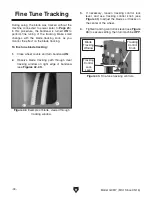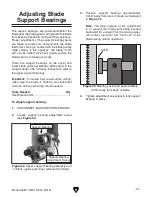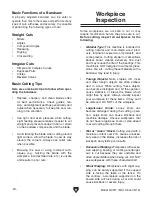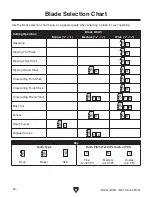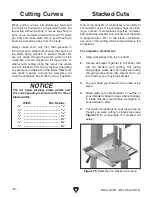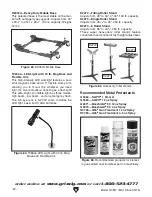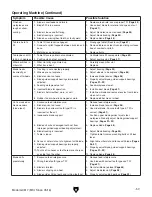
Model G0817 (Mfd. Since 05/16)
-43-
Bi-metal Blade: A strip of high-speed tool steel is
precision welded to a flexible carbon blade, then
teeth are ground into the blade to provide good
edge-holding qualities for blades taking a lot of
abuse (see
Figure 70).
Carbon Steel Blade
Weld
High-Speed Steel
Figure 70. Bi-metal blade composition.
Tooth Set
Two common tooth sets for wood bandsaw blades
are alternate and raker. Each different type of
tooth set removes material in a different manner,
leaving cuts with different characteristics (see
Figure 68).
Alternate
Raker
Figure 68. Common woodcutting bandsaw blade
tooth sets.
•
Alternate: An all-purpose arrangement
where the teeth are bent evenly left and right
of the blade.
•
Raker: Three teeth in a recurring group—one
bent left, one bent right, and then one that is
not bent. The raker set is ideal for most con-
tour cuts.
Tooth Pitch
Measured as TPI (teeth per inch), tooth pitch
determines the number of teeth. More teeth per
inch (fine pitch) will cut slower, but smoother; while
fewer teeth per inch (coarse pitch) will cut rougher,
but faster. As a general rule, choose blades that
will have at least three teeth in the material at all
times. Use fine-pitched blades on harder woods
and coarse-pitched blades on softer woods.
Carbon Steel
Carbide Impregnated Steel
Figure 69. Carbide-tooth blade composition.
Blade Material
Bandsaw blades must meet two requirements:
flexibility and hardness. The flexibility of a blade
allows it to travel on the wheel as a band, while
hardness allows the teeth to cut and hold an
edge. Modern materials technology has allowed
bandsaw blades to meet these requirements in
various ways.
Carbon Steel: These blades are differentially
heat treated to provide hard teeth that will hold an
edge, and yet be flexible in the back.
Carbide Tooth: Extremely hard carbide is either
welded onto or impregnated into the carbon steel
blades, providing superior edge-holding charac-
teristics (see
Figure 69).
Summary of Contents for G0817
Page 88: ......


